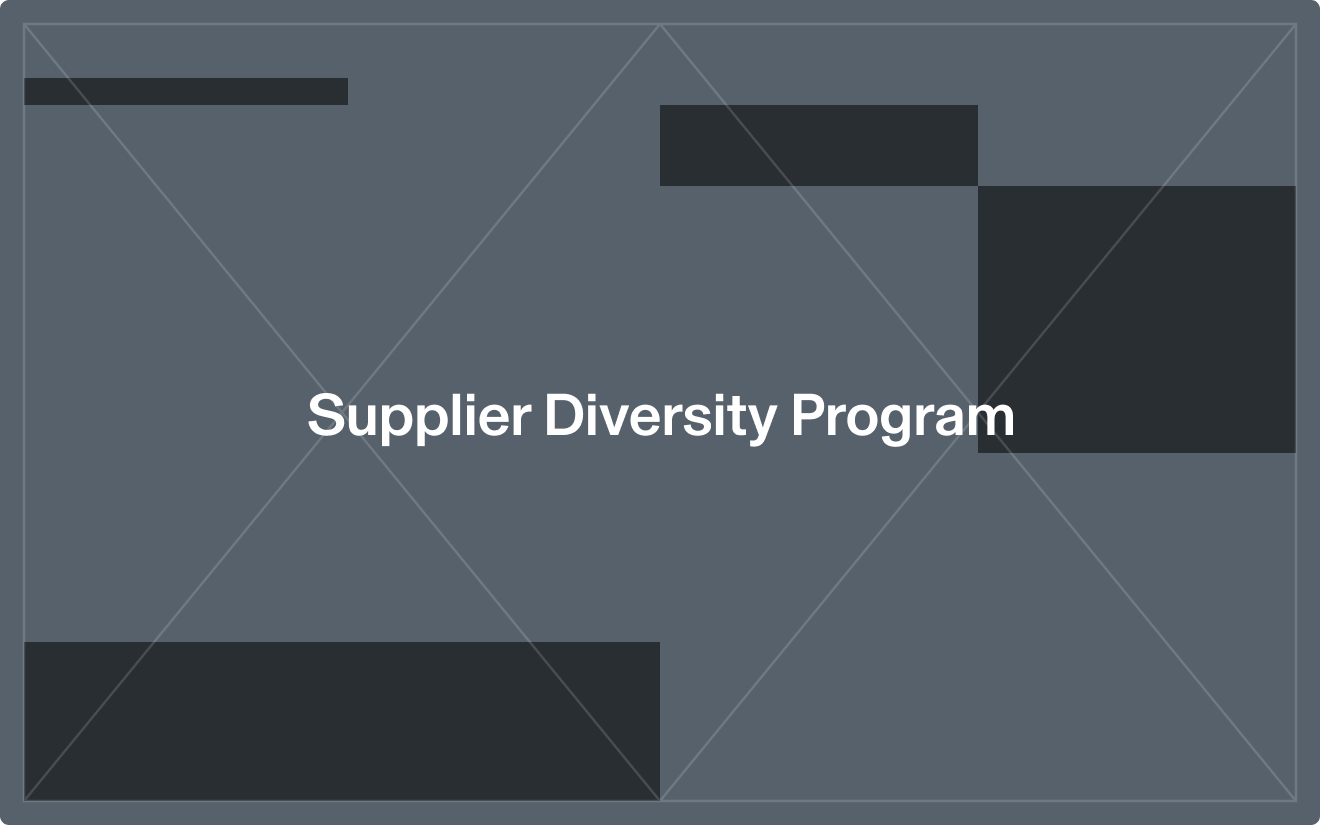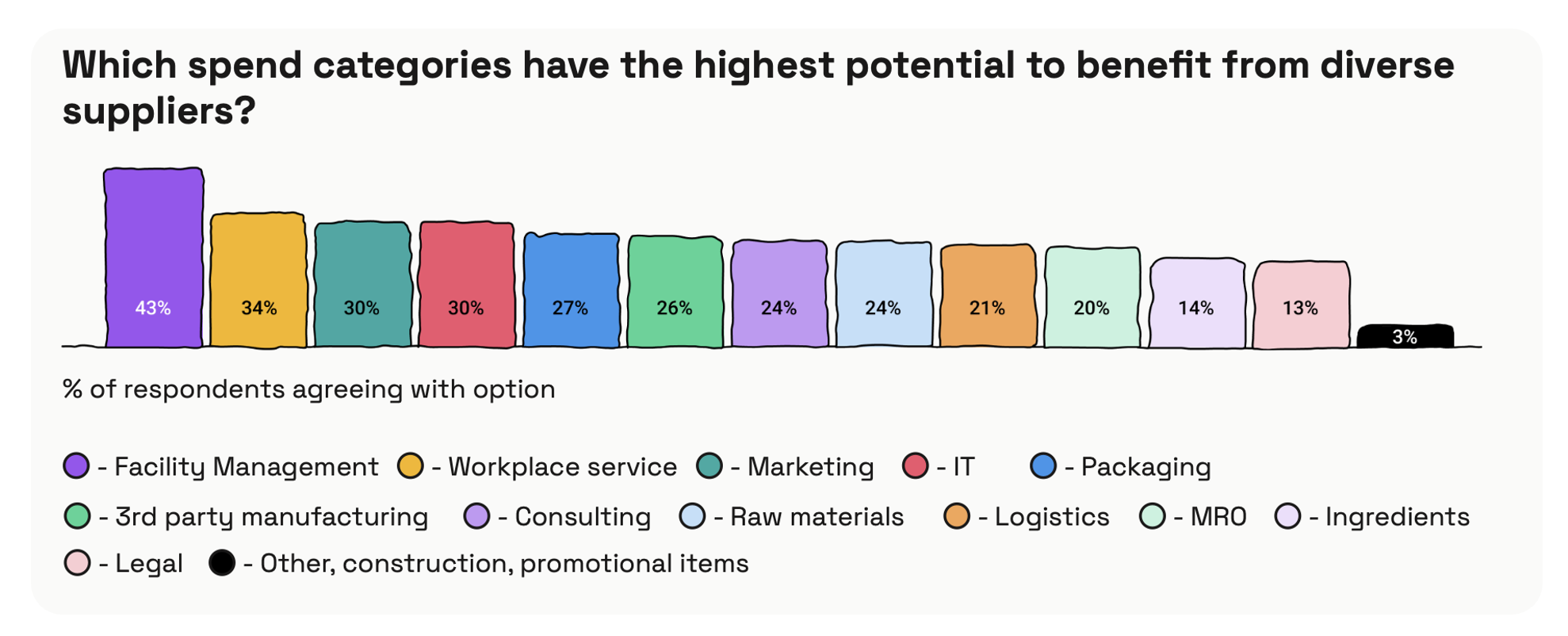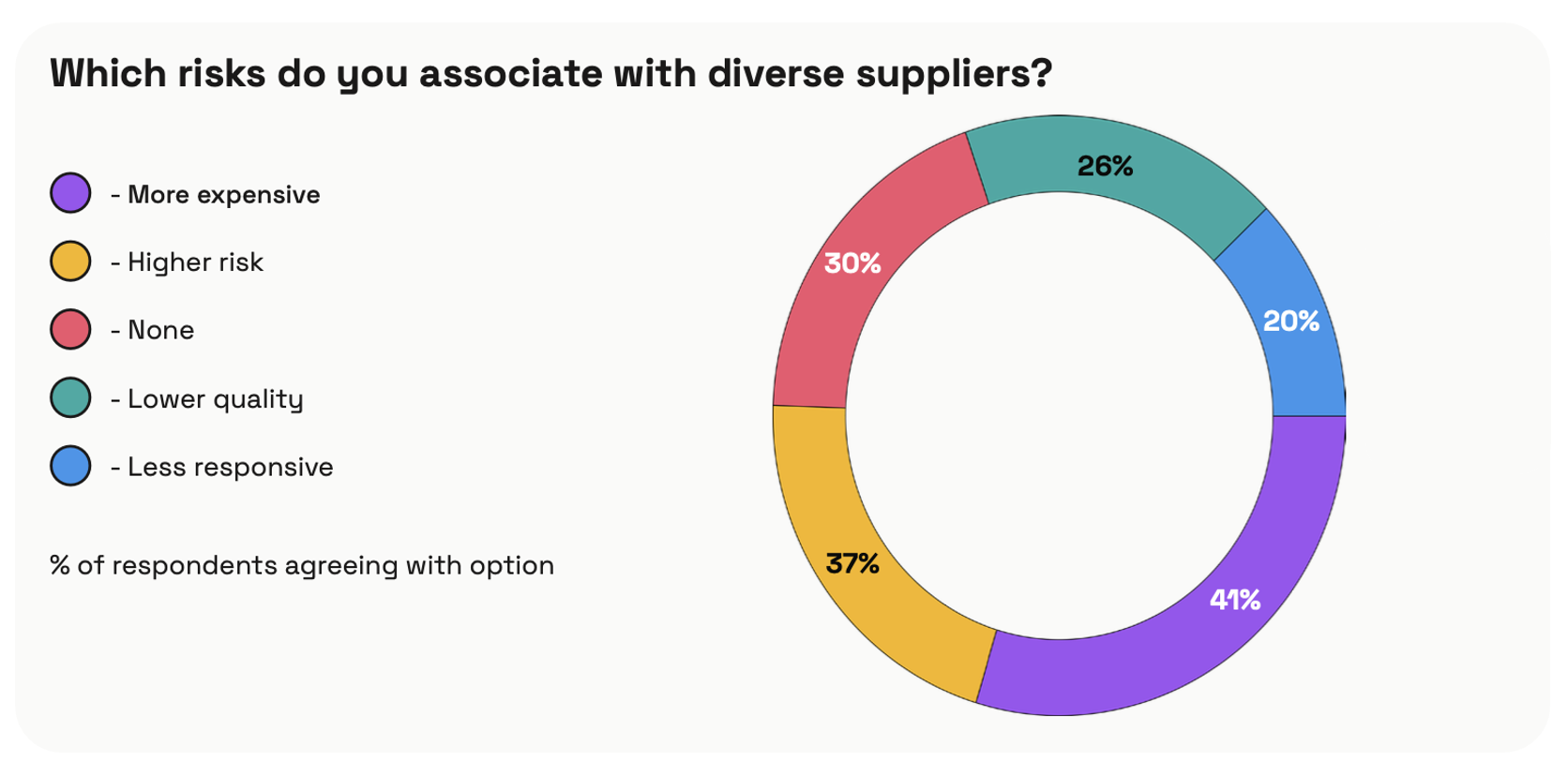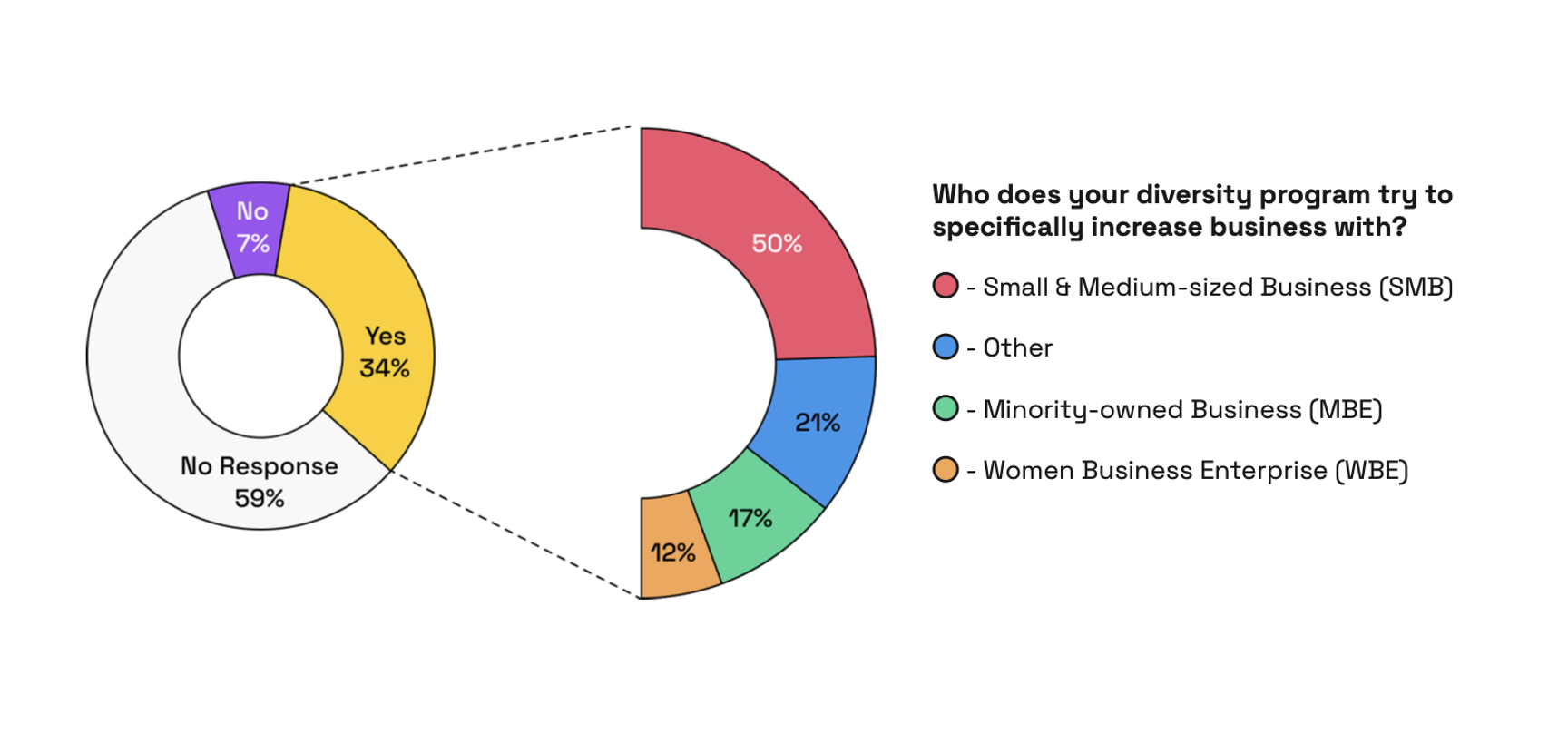Against all odds: Overcoming conflicting objectives of supplier diversity programs in Procurement

Against all odds: Overcoming conflicting objectives of supplier diversity programs in Procurement
There are two main reasons why supplier diversity programs conflict with classic Procurement objectives like supplier harmonization or spend bundling: The size of the companies that qualify as diverse suppliers and the products and services they supply. These conflicts need to be tackled head on when establishing a supplier diversity program to ensure procurement professionals can see beyond the obvious contradictions.
Procurement has always been a key driver for positive change and most companies rely on their Procurement teams to deliver on their Environmental, Social, Governance (ESG) agenda. Next to sustainability in strategic Procurement, supplier diversity programs are a major opportunity for businesses to extend their Diversity, Equity, and Inclusion (DEI) ambitions and for Procurement to strengthen their profile beyond managing costs.
In our blog ‘A step-by-step guide to creating a supplier diversity program’ we explained how to approach and position supplier diversity with senior leaders and how to get started. In this blog, we will explore the obstacles and arguments you will be confronted with and must overcome to make it successful. But where is the conflict even coming from?
The conflict is rooted in the definition of what a diverse supplier is
Definitions of diverse suppliers differ slightly across countries but usually recognize two types of suppliers. The first one is based on the size of an organization in terms of its headcount or turnover. This definition is available in almost every country and usually distinguishes between micro, small, and medium sized companies.
The second one is based on the ownership status of the business. This definition covers businesses that are at least 51% owned, operated, or controlled by an individual or group that is part of a traditionally underrepresented or marginalized group. This definition is mostly used in countries with ties to the British Commonwealth and the United States today but slowly gains popularity in additional countries.
The definition of small and diverse suppliers immediately raises the question though, where these suppliers can be found in the current spend profile of organizations. Irrespective of looking through the lens of company size or ownership structure, small and diverse suppliers are mostly found in indirect spend categories and more generally speaking in the long tail.
This makes sense, as delivering large volumes to multi-national companies with billions of spend usually requires a larger organizational footprint and funding that is rarely found in small companies. But the combination of small suppliers and small spend is the root cause for the conflict experienced by procurement professionals, especially in large multi-national organizations.

Overcoming the challenges of running a successful supplier diversity program
Procurement is trying to leave its perception of being solely focused on savings behind. Unfortunately, this is not necessarily reflected in the individual targets of professionals. Having good intentions for establishing a supplier diversity program alone will therefore not be enough to make it successful. Instead, potential target conflicts need to be addressed from the beginning and head on.
Some ideas and objectives of supplier diversity programs are directly opposing core objectives or strategies of Procurement. Being aware of these conflicts allows us to develop convincing arguments and mitigating actions before they become issues that distract from the cause.
We have compiled the main challenges across 7 dimensions and how to resolve them below.

1. Savings delivery
It’s fairly safe to say that Procurement always has been and always will be about managing cost. Inevitably, this means that delivering cost savings will also remain a core objective of Procurement functions. One main approach to achieving savings is to leverage and bundle volumes, thereby achieving volume discounts with suppliers. The introduction of smaller suppliers will limit the ability to bundle volumes, thereby creating a target conflict. So far, so reasonable.
While this narrative makes sense on a meta level, there are two main reasons why Procurement might still deliver on its savings objectives when introducing more diverse suppliers. First, adding new suppliers increases competition. Smaller suppliers with less overhead add new price points to the discussion, allowing procurement to leverage this insight when negotiating with large vendors and incumbents. Secondly, diverse suppliers are unlikely to cover the full demand. The leverage from volume bundling should therefore still exist. Applying scenario-based analysis allows Procurement to see the impact of their decisions on savings opportunities easily and have fact-based discussions around it.
2. Supplier consolidation
Next to creating leverage through bundling volumes, rationalizing and consolidating the number of suppliers has various other benefits to Procurement, making it another key objective. There is a cost associated with every supplier on the system and Procurement teams only have so much time that can be spent on maintaining direct relationships with suppliers. Especially managing the tail spend is therefore a key objective for many organizations. The idea of introducing diverse suppliers that will most likely sit in the tail with limited spend is therefore a major contradiction.
The argument is very valid, but diverse suppliers will mostly already be in the system. A supplier diversity program aims to identify and track these suppliers and to develop a targeted supplier strategy for building more meaningful relationships. Supplier diversity doesn’t have to be in conflict with the idea of supplier consolidation but can even support the evolution towards more tailored supplier development programs. Thinking in scenarios helps you understand the implications of awarding business across different supplier sets and makes discussions around it more objective.
3. Cashflow management
Managing the cashflow of an organization is a vital task and payment terms are a great way to impact the cashflow. But for many procurement professionals, payment terms are a red flag. The initiatives are driven by Finance and the arguments weak, which makes conversations with suppliers at times uncomfortable. This is especially true when standard payment terms beyond 30 days are required from small and diverse suppliers.
The desire to maximize payment terms is rational, but small and diverse suppliers also need to manage their cashflow. The impact of long payment terms with small suppliers, individually and as a whole, to the organization is marginal. Instead of applying a one size fits all mindset, organizations should define supplier friendly payment terms of 30 days or less for participants of their supplier diversity program. By clearly tracking the cash flow implications and benefits of the program, the discussion becomes objective and more impactful approaches for managing cash can be identified.

4. Process design
Procurement is the window to the external market and has various processes in place that are designed to safeguard the organization against risks of internal and external malpractice. From supplier lifecycle management to sourcing, contracting and purchasing, processes tend to be elaborate and…bureaucratic. While it is important to be diligent and have sound governance practices in place, standard processes rarely take the unique situations of small and diverse suppliers into consideration, which creates a target conflict.
Procurement needs to balance the risk to the business with the expected benefits of engaging diverse suppliers. To ensure appropriate checks and balances are in place, Procurement should review its key processes and design a lighter version that considers the unique situation of small and diverse suppliers. Less onboarding questions, less formal certifications, shorter contracts, faster decisions. By designing processes in line with the objective of the supplier diversity program, it will limit the risk exposure while enabling frictionless supplier engagement.
5. Organizational structure
Procurement teams in large organizations are often global and centralized. They operate around spend categories and it is very difficult for external parties to identify who oversees which category on a global or local level. Diversity programs often sit outside of this structure and have no direct control over category teams or sourcing decisions. Paired with limited resources for supporting the program, the organizational structure is a key obstacle for running a successful diversity program, especially as diversity is a very local topic that needs to be tailored by market.
Increasing the headcount to support diversity will not solve the structural challenge. Organizations need to change the behaviors across markets to be successful. A clear focus on putting in place the right process, communicating across the entire team and local representation in key markets, even on a voluntary basis, can help overcome the organizational barriers to running a successful supplier diversity program.
6. Supplier visibility
Many strategic Procurement levers harness the benefits of supplier consolidation as described above. The focus on a few large suppliers automatically places small suppliers in the long tail, which is considered undesirable by category managers. On top, small suppliers don’t have the same means to invest into the sales process and relationship building as large organizations. This position and perception complicate the transition towards a more inclusive supply chain as diverse suppliers are basically invisible to corporate Procurement teams.
While this is a challenge, it is one that can be overcome. If the suppliers can’t break through to you, you need to go out and find them. Enhancing the existing supplier data with the help of a specialized technology solutions can help uncover existing unmanaged relationships with diverse suppliers and suggest new ones that can be developed going forward. Also, working with local minority certification agencies can be an easy starting point for identifying and engaging diverse suppliers. Advanced analytics capabilities can ensure that inviting a larger number of suppliers doesn’t become a burden to the sourcing process.
7. Positive discrimination
Why start a supplier diversity initiative now? The focus on a very targeted group of suppliers might be perceived as a form of positive discrimination. While the arguments for attracting new sources of innovation, increasing supply chain resilience or accessing new market segments are sound, they can also be challenged, especially in markets that are more homogeneous or less sensitive to the challenges of minorities.
Highlighting one group is always coming at the expense of another. Defining the definition and scope of the supplier diversity program is therefore the key for success. By expanding the focus beyond minority-owned business to including small suppliers in the broader sense helps creating an inclusive rather than segregated approach. Tracking the spend with different types of diverse suppliers over time helps demonstrate the overall progress and enables fact-based discussions on the impact of the program on different communities.

Operationalizing your supplier diversity program
Procurement continues to evolve beyond cost savings and establishes itself as a key driver for positive change. Owning the Environmental, Social, Governance (ESG) agenda has helped Procurement claim its seat at the table. By defining and operationalizing business objectives through supplier engagement and sourcing activities, Procurement strengthens its profile as a strategic business partner. Expanding from sustainability to supplier diversity will be a powerful next step.
Increasing supplier diversity is the right thing to do. But more importantly, it is an investment into a more innovative, cost effective, and resilient supply chain. Actively including diverse suppliers into the sourcing process and evaluating the impact of diversifying the supply base across different award scenarios enables powerful conversations with internal stakeholders and suppliers alike.
Interested in diving deeper into the topic? Then download our free whitepaper ‘A practical introduction to supplier diversity’ here. It provides a holistic introduction to supplier diversity and gives you a comprehensive guide for establishing and operationalizing your own supplier diversity program.
Interested to learn how Archlet can help operationalise Supplier Diversity scores into your sourcing decisions. Book a demo now.


